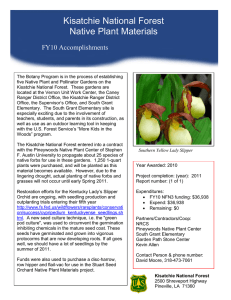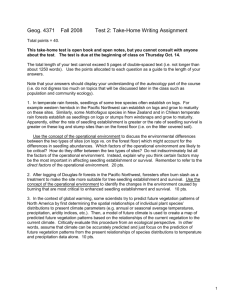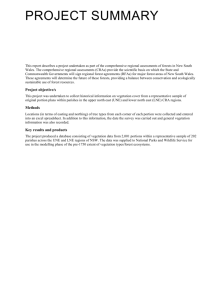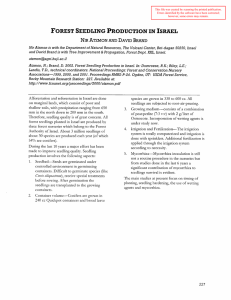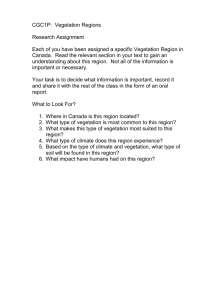Rapid Response Reforestation: Studies in Fire Restoration Robin Rose Diane L. Haase
advertisement
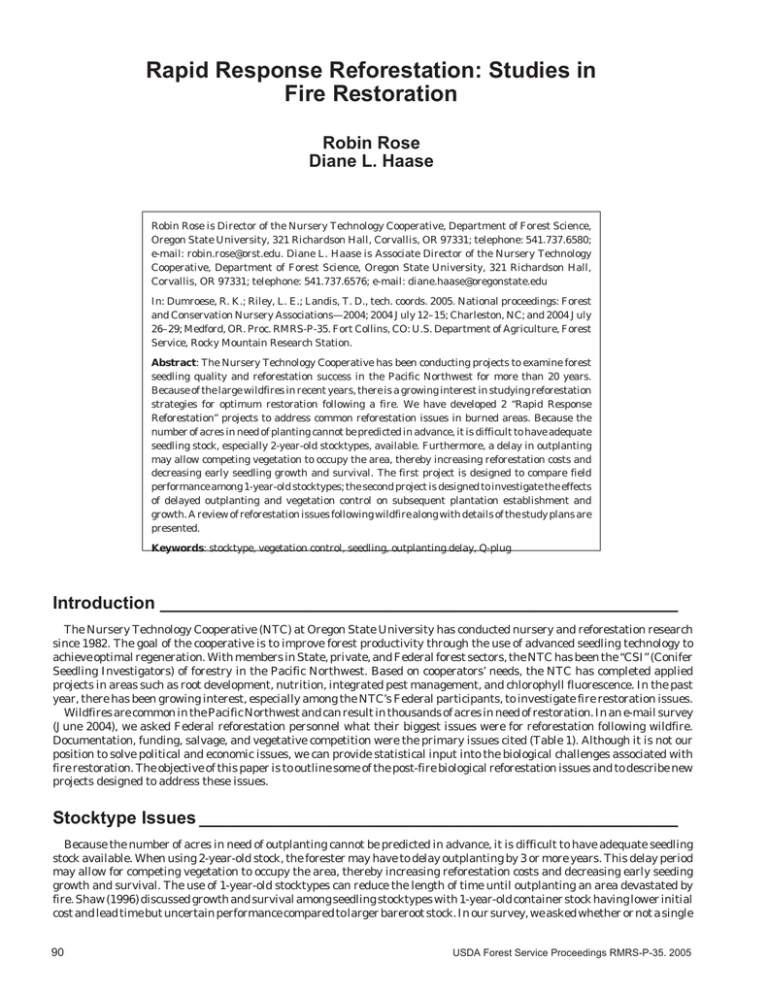
Rapid Response Reforestation: Studies in Fire Restoration Robin Rose Diane L. Haase Robin Rose is Director of the Nursery Technology Cooperative, Department of Forest Science, Oregon State University, 321 Richardson Hall, Corvallis, OR 97331; telephone: 541.737.6580; e-mail: robin.rose@orst.edu. Diane L. Haase is Associate Director of the Nursery Technology Cooperative, Department of Forest Science, Oregon State University, 321 Richardson Hall, Corvallis, OR 97331; telephone: 541.737.6576; e-mail: diane.haase@oregonstate.edu In: Dumroese, R. K.; Riley, L. E.; Landis, T. D., tech. coords. 2005. National proceedings: Forest and Conservation Nursery Associations—2004; 2004 July 12–15; Charleston, NC; and 2004 July 26–29; Medford, OR. Proc. RMRS-P-35. Fort Collins, CO: U.S. Department of Agriculture, Forest Service, Rocky Mountain Research Station. Abstract: The Nursery Technology Cooperative has been conducting projects to examine forest seedling quality and reforestation success in the Pacific Northwest for more than 20 years. Because of the large wildfires in recent years, there is a growing interest in studying reforestation strategies for optimum restoration following a fire. We have developed 2 “Rapid Response Reforestation” projects to address common reforestation issues in burned areas. Because the number of acres in need of planting cannot be predicted in advance, it is difficult to have adequate seedling stock, especially 2-year-old stocktypes, available. Furthermore, a delay in outplanting may allow competing vegetation to occupy the area, thereby increasing reforestation costs and decreasing early seedling growth and survival. The first project is designed to compare field performance among 1-year-old stocktypes; the second project is designed to investigate the effects of delayed outplanting and vegetation control on subsequent plantation establishment and growth. A review of reforestation issues following wildfire along with details of the study plans are presented. Keywords: stocktype, vegetation control, seedling, outplanting delay, Q-plug Introduction _____________________________________________________ The Nursery Technology Cooperative (NTC) at Oregon State University has conducted nursery and reforestation research since 1982. The goal of the cooperative is to improve forest productivity through the use of advanced seedling technology to achieve optimal regeneration. With members in State, private, and Federal forest sectors, the NTC has been the “CSI” (Conifer Seedling Investigators) of forestry in the Pacific Northwest. Based on cooperators’ needs, the NTC has completed applied projects in areas such as root development, nutrition, integrated pest management, and chlorophyll fluorescence. In the past year, there has been growing interest, especially among the NTC’s Federal participants, to investigate fire restoration issues. Wildfires are common in the Pacific Northwest and can result in thousands of acres in need of restoration. In an e-mail survey (June 2004), we asked Federal reforestation personnel what their biggest issues were for reforestation following wildfire. Documentation, funding, salvage, and vegetative competition were the primary issues cited (Table 1). Although it is not our position to solve political and economic issues, we can provide statistical input into the biological challenges associated with fire restoration. The objective of this paper is to outline some of the post-fire biological reforestation issues and to describe new projects designed to address these issues. Stocktype Issues _________________________________________________ Because the number of acres in need of outplanting cannot be predicted in advance, it is difficult to have adequate seedling stock available. When using 2-year-old stock, the forester may have to delay outplanting by 3 or more years. This delay period may allow for competing vegetation to occupy the area, thereby increasing reforestation costs and decreasing early seeding growth and survival. The use of 1-year-old stocktypes can reduce the length of time until outplanting an area devastated by fire. Shaw (1996) discussed growth and survival among seedling stocktypes with 1-year-old container stock having lower initial cost and lead time but uncertain performance compared to larger bareroot stock. In our survey, we asked whether or not a single 90 USDA Forest Service Proceedings RMRS-P-35. 2005 Rapid Response Reforestation: Studies in Fire Restoration Rose and Haase Table 1—Survey responses to the question, “What are your biggest issues when it comes to reforestation after wildfire?” Fremont-Winema NF(4 respondents) 1. Fire salvage and reforestation cost much more than treating green stands—is it worth it? Problems with getting fire salvage done in a timely manner, number and arrangement of snags to be left for wildlife, and snag/hazard trees. 2. Available funds are often inadequate for site prep or damage control. 3. Getting trees in the ground before competition and gopher populations occupy the site. 4. Completing and implementing the NEPA document. Umpqua NF Loss of 5,000 plantation acres to fire with inadequate funding for planting. Okanogan-Wenatchee NF Obtaining adequate funding. Overstocked stands in dry areas are prone to severe fires, which require large reforestation investments. Rogue River-Siskiyou NF Location! Moisture is the most limiting factor. Grass seeding and straw bales to control erosion create competition and potential for introducing noxious weeds. Deschutes NF Competing vegetation can be attributed to all their reforestation problems. Malheur NF Ceanothus spp. competition and gopher damage are big issues with no budget to treat either problem. Medford BLM NEPA issues and securing funding are more time consuming and problematic than biological concerns or constraints. seedling stocktype performed better than others for fire restoration. The relative performance among stocktypes varied considerably depending on site conditions, species, and location (Table 2). NTC Project to Compare 1-Year-Old Stocktypes This study is designed to compare performance of conifer seedling stocktypes outplanted following wildfire. To maximize the applicability of these results, the number of outplanting sites is just as important as the stocktypes being compared. The following 3 sites were installed in 2004 (with the possibility of additional sites to be outplanted in 2005): 1. Southern Oregon Cascade site (Medford BLM), 3,000 ft (910 m) elevation, 40 mi (64 km) north of Medford, OR—2002 Timbered Rock Fire, Douglas-fir—(Pseudotsuga menziesii) (Q-plug, Styro-15, 2+0, 1+1), outplanted March 23, 2004. Additional 2+0 and 1+1 seedlings will be outplanted in 2005. 2. Southern Oregon Coast site (Medford BLM), 3,800 ft (1,160 m) elevation, 25 mi (40 km) northwest of Merlin, OR— 2002 Biscuit Fire, Douglas-fir (Q-plug, Styro-15, 1+1), outplanted March 23, 2004. Additional 1+1 and plug+1 seedlings will also be outplanted in 2005. Table 2—Survey responses to the question, “Have you found that one seedling stocktype or species works better than another for fire restoration?” Fremont-Winema NF (3 respondents) 1. Best stocktype is 2+1, with 2+0 being okay. Poor performance with 1-year-old stock (possibly due to harsh seasons when using this stock, later hardening, or gopher damage). 2. Depends on site conditions. Prefers 1+1 because they are “meatier” than 1+0 and not as tall as 2+0. 3. Bareroot 2+0 have performed better than 1+0. Recently planted Q-plug and will evaluate. Umpqua NF Using a lot of container and Q-plug this year on the Tiller Complex Fire. These are looking very good (better than 2+0). Have not had success with 1+0 bareroot. Okanogan-Wenatchee NF (2 respondents) 1. Success with spring-planted container or bareroot. For summer planting (Aug to Sep), bareroot generally fail while container does well. Using copper styroblock for all pine and much of their Douglas-fir. 2. Superior performance with 2-year-old bareroot as compared to container stock. Rogue River-Siskiyou NF Need to reforest ASAP. Using plugs because of lead time and funding unknowns. Are moving into Q-plugs this fall/spring. Deschutes NF No differences found among stocktypes with the exception of some heldover 2+1 ponderosa pine stock on the Eyerly fire (although this stocktype is not practical to grow for fire). Malheur NF Using 1+0 and Styro-5 ponderosa pine in fire areas because they tend to do well in rocky, dry sites. Douglas-fir and western larch containers have lower survival—larger seedlings are better for these species. Medford BLM Site dictates the stocktype. Using 1+1 Douglas-fir on good soil with higher precipitation but often use container stock to save growing time. Styro-5 ponderosa pine is a consistent performer and lower cost. Minor species do well as Styro-8 or larger. USDA Forest Service Proceedings RMRS-P-35. 2005 91 Rose and Haase Rapid Response Reforestation: Studies in Fire Restoration 3. Northeastern Washington site (Wenatchee NF), 4,800 ft (,1460 m) elevation—2002 Deer Point Fire, ponderosa pine—(Pinus ponderosa) (Q-plug and 415B), outplanted May 12, 2004. Note: A survey on July 13, 2004, found 98% survival for both stocktypes. For each site, the same seedlot was used regardless of stocktype. The Q-plug stocktype is a 1-year-old seedling, 3 sown in a 1-in (16-cc) stabilized media plug (International Horticultural Technologies, LLC, Hollister, CA) in midwinter and grown under greenhouse conditions for several months, transplanted in bareroot beds in early spring, and lifted the following winter. At each outplanting site, the study was installed in a randomized complete block design. Treatment plots were randomly assigned within blocks. Planting was done at an operational spacing. All seedlings are protected from browse with mesh tubes. Seasonal height, stem diameter, and survival will be measured. Instances of browsing, chlorosis, frost damage, dead tops, and browning will also be recorded. Growth will be calculated by subtracting initial values. Seedlings will continue to be measured annually to determine long-term differences among stocktypes. Data will be analyzed using analysis of variance (ANOVA). Fisher’s Protected Least Significant Difference procedure will be used to determine significant differences in data among stocktypes at the a = 0.05 level. Each site will be analyzed separately. wildfire and salvage logging, there was 93% survival with scarification site prep and 76% without scarification (Densmore and others 1999). In another study, removal of shrubs resulted in increased survival and growth following fire (De las Heras and others 2002). Additionally, the use of grass seeding to control erosion and increase forage can result in significant seedling mortality (Lehmkuhl 2002). In our survey, respondents cited various delays to outplanting following fire (Table 3) and most noted vegetative competition as a resulting problem. On the Medford BLM District, 10-year records indicate that delays that allowed 2 or more seasons for vegetation to recover after disturbance negatively affected seedling survival and increased the need to interplant and/or replant from an average of 3% with timely outplanting to an average of 22% when delays occurred (Henneman 2004). Data from the Vegetation Management Research Cooperative (VMRC) indicate significant gains in conifer seedling stem volume with weed control. After 8 years, trees grown in plots with 3 years control of woody weeds, herbaceous weeds, or total weed control had stem volume increases of 81%, 172%, and 307%, respectively, as compared to seedlings grown in plots without control of competing vegetation. Additionally, increasing the weed-free area around a seedling results in increasing growth responses (Rose and others 1999; Rose and Ketchum 2002). Outplanting Delay Issues ________ NTC Project to Investigate the Effects of Outplanting Delay and Vegetation Control Following a disturbance from wildfire, delay until reforestation can have significant impacts on subsequent survival and growth. There is a declining probability of success over time for seedlings outplanted after a fire without vegetation control (Newton and Lavender, unpublished in Sessions and others 2003). In a study with container-grown white spruce (Picea glauca) seedlings outplanted after This study will be initiated in 2005. Operational stock will be used for each site. Although stock will be outplanted over a 3-year period, the same seedlot, species, and stocktype must be used at each outplanting for each site. To maximize the applicability of these results, 2 to 4 outplanting sites will be selected for inclusion in the study. Table 3—Survey responses to the question, “Have you had to delay planting after wildfire? If so, why? Did this result in problems such as erosion or competing vegetation?” Fremont-Winema NF (3 respondents) 1. Planning process takes 2 years anyway, so there is not a need to use 1-year-old stock. Competition is not a problem since grass seeding was stopped. Funding and removal of hazard trees are also delaying factors. 2. Delay due to NEPA (1 year) and harvest (1 year), ordering seedlings, funding, and available personnel. 3. Delay due to NEPA. Problems with vegetative competition result. Umpqua NF Delay is largely due to funding. Okanogan-Wenatchee NF Delays due to bareroot seedlings not immediately available, fire area too large to handle in a single season, salvage logging (NEPA timelines and public controversy). Can result in substantial competing vegetation on some sites. Rogue River-Siskiyou NF Delay due to site prep and fuels reduction to minimize possibility of reburn. Deschutes NF Biggest delay due to not enough seedlings to plant. Delays also due to NEPA and salvage. Competing vegetation is a serious problem. Malheur NF Planting must wait for logging and NEPA to be completed. Need to get seedlings planted in time to keep them above the Ceanothus spp. Medford BLM Have been fortunate to be able to plant 14 to 20 months following fire. Erosion is mitigated with grass/ forb mixes put down within the first few months after fire. 92 USDA Forest Service Proceedings RMRS-P-35. 2005 Rapid Response Reforestation: Studies in Fire Restoration A factorial treatment structure will be used (outplanting time x vegetation control). Outplanting treatments will be 1, 2, or 3 seasons after wildfire. Vegetation control levels will be: OO, OT, TO, TT. The Ts (treated) and Os (untreated) represent individual years beginning at the time of outplanting. There are a total of 12 treatments (3 outplanting times x 4 vegetation control levels) that will require 4 years to establish. Vegetation control treatments were selected based on research conducted by the VMRC, which showed that delaying vegetation control for a year may result in a similar or even larger tree growth response than vegetation control initiated at the time of outplanting. (Note: this may also be a result of good site preparation.) We suspect that effect may diminish when outplanting is delayed for 2 or 3 years and competing vegetation has an opportunity to establish. At each outplanting site, the study will be installed in a randomized complete block design. Each block will consist of 12 randomly assigned treatment plots (1 for each outplanting/vegetation treatment). Outplanting will be done at an operational spacing, and all seedlings will be protected from browse with mesh tubes. Initial field height and stem diameter will be measured within one month after outplanting, prior to budbreak. Instances of browsing, chlorosis, frost damage, dead tops, and browning will also be recorded. Height, stem diameter, and survival will be assessed again the following September for first season field performance. In addition, the percentage of cover for grasses, forbs, and woody weeds will be estimated for each plot and the primary species recorded for each weed category. Plots will continue to be measured annually to determine long-term differences among treatments. Data will be analyzed with ANOVA. Each site will be analyzed separately. Tests for normality, linearity, and constant variance of the residuals will be performed to determine if data transformations are necessary. Fisher’s Protected Least Significant USDA Forest Service Proceedings RMRS-P-35. 2005 Rose and Haase Difference procedure will be used to determine significant differences in data among treatments at the a = 0.05 level. Acknowledgments _____________ We appreciate the following individuals for providing significant input into this report: Lee Rosner, Dave Henneman, Dave Steinfeld, Larry Shaw, Randy Niman, Donna Stubbs, Sue Puddy, Norm Michaels, Steve Bulkin, Phil Jahns, Anthony Johns, Kandy Hill, Dave Priest, John Townsley, Chris Rusch, and Steve Mooney. References ____________________ De la Heras J, MartÌnez-Sanchez JJ, Gonzalez-Ochoa AI, Ferrandis P, Herranz JM. 2002. Establishment of Pinus halepensis Mill. saplings following fire: effects of competition with shrub species. Acta Oecologica 23:91-97. Densmore RV, Juday GP, Zasada JC. 1999. Regeneration alternatives for upland white spruce after burning and logging in interior Alaska. Canadian Journal of Forest Research 29:413-423. Henneman D. 2004. Personal communication. Medford (OR): USDI Bureau of Land Management, Medford District. Lehmkuhl JF. 2002. The effects of spring burning and grass seeding in forest clearcuts on native plants and conifer seedlings in coastal Washington. Northwest Science 76:46-60. Rose R, Ketchum JS, Hanson DE. 1999. Three-year survival and growth of Douglas-fir seedlings under various vegetation-free regimes. Forest Science 45:117-126. Rose R, Ketchum JS. 2002. Interaction of vegetation control and fertilization on conifer species across the Pacific Northwest. Canadian Journal of Forest Research 32:136-152. Sessions J, Buckman R, Newton M, Hamann J. 2003. The Biscuit Fire: management options for forest regeneration, fire and insect risk reduction and timber salvage. Corvallis (OR): College of Forestry, Oregon State University. 63 p. Shaw LS. 1996. Conifer seedling choices in wildfire reforestation— eastside perspectives. In: Landis TD, South DB, technical coordinators. National proceedings, Forest and Conservation Nursery Associations. Portland (OR): USDA Forest Service, Pacific Northwest Research Station. General Technical Report PNW-GTR389. p 207-210. 93
